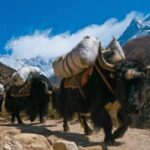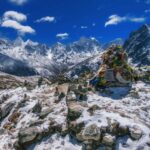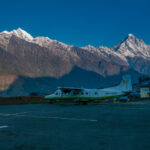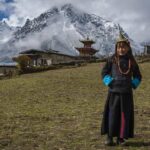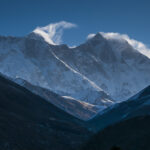This is a complete guide to our Everest base camp trek packing list. We have updated it with the items that we should have brought with us and must have items on your packing list for the EBC Trek.
So you have finaly decided to fulfill the ultimate bucket list item of trekking to Everest Base Camp. But how do you pack for such a trip? Don’t worry, we’ve done it and have since done many other treks in the Himalayas and through mountains aroudn the world. We have perfected (well, as much as we can) our packing list and created the ultimate packing guide for your Everest Base Camp Trek.
Everest Base Camp Packing List
It is a little daunting planning a trek to Everest. But the most daunting task together a packing list for our Everest Base Camp Trek. While in Kathmandu, we packed and unpacked our bag several times before feeling good about our gear.
You want to pack light but you want to make sure you have enough gear to survive the colder temperatures and the 14 days of trekking above 4000 meters. (13,123 feet).
We got our gear down to one backpack between us and two day packs that we carried oursleves. That included camera gear.
Here is a list of the gear that we packed for Everest.
Quick Tips – Packing Gear for Everest Base Camp
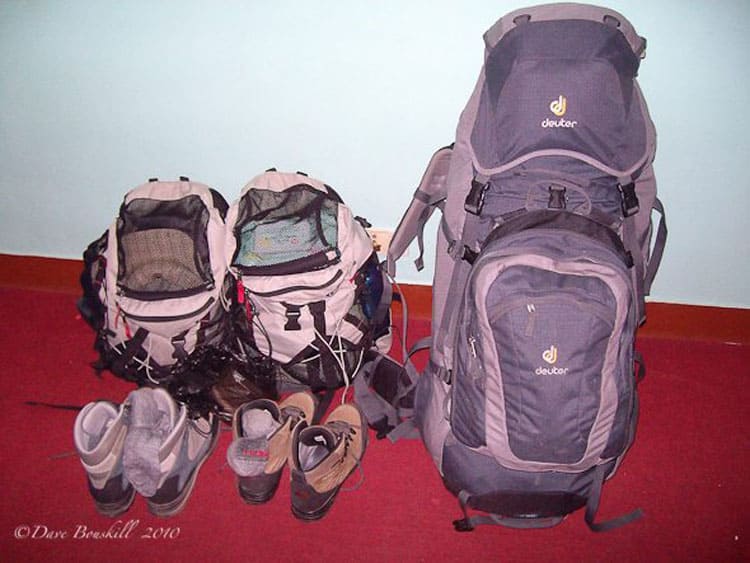

This list is for 1 person, we each brought the same amount of travel gear, but to keep things simple, we are including only what 1 person needs to pack for Everest Base Camp.
It is important to pack layers for your Everest Base Camp trek.
Wear lightweight clothing that is breathable
Dress in layers so you can peel them off when you get hot, and add them as it gets cold. Three layers is perfect for trekking:
- Base Layer – Merino Wool top and bottoms. It is lightweight, breathes, and doesn’t smell making it perfect for wicking away moisture.
- Mid Layer – We wore fleece as our base layer on Everest. Fleece pants and a zip-up fleece jacket. When we got to colder and higher elevations, we worked a lightweight down jacket which.
- On other treks in the Himalayas, we have since switched to a thicker merino wool jacket. It is more breathable. And have stuck with our lightweight Canada Goose Hybridge down jacket.
- Outer layer – Choose something that is waterproof and breathable Nylon or polyester material. We use GoreTex and have for years. it is durable, waterproof, windproof and breathable. That is very much the key. If you get an outerlayer that isn’t breathable, you will sweat and it will hold in the moister. Getting wet and cold is dangerous.
- Read our complete 5 Winter Layering Tips to Dress for the Deep Freeze
Weather can change rapidly. One minute you can be working up a sweat as you climb uphill and then as the temperature drops, you will be freezing in the cold.
Make sure to have tested all of your gear before trekking to Base Camp. Don’t wear new boots on the trek, make sure that they are worked in. Do several hikes at home before trekking to Everest. Boots should be worn in and comfortable.
Also, check all batteries in headlamps and cameras before your flight to Lukla. Charging stations are limited on the Everest base camp trek, so be sure to have every charged up and bring plenty of spares.
Trekking clothes for Everest


- 2 quick drying long sleeved base layer shirts – Light weight and quick dry is key. We brought 2 to be able to alter them daily.
- 2 trekking shirts short sleeve – Even though it is chilly, you will get hot. Short sleeved shirts are good to wear at lower altitudes.
- 2 Thermal underwear – A good merino wool base layer is a must. We suggest packing 2 pairs of thermal underwear so that you can air out one each night. Or change into dry thermal underwear at the tea houses to sleep in after your trek while letting your other base layer dry.
- 2 liner socks – Liner socks are good to wear under trekking socks to which away moisture and prevent blisters.
- 3 pair woolen blend trekking socks – You could pack four pairs, but three is enough. 2 is not enough as you’ll need to dry socks at the end of the day and have another to wear while lounging at the
- 2 pair trekking pants – When trekking we prefer zip-off bottoms. I tend to run hot when trekking and I always zip off my pants in mid day but like the option of zipping them back on when stopping.
- 2 fleece sweaters – Midlayer – one lightweight, one heavier. It gets cold over 5000 meters, so you’ll want a warmer mid layer.
- Underwear – We like clean underwear and don’t like washing in the middle of a trek every night. We packed 7 pairs each. Really, underwear doesn’t take up much space. But if you like to wash, go ahead and pack lighter.
Outer Layers for EBC Trek
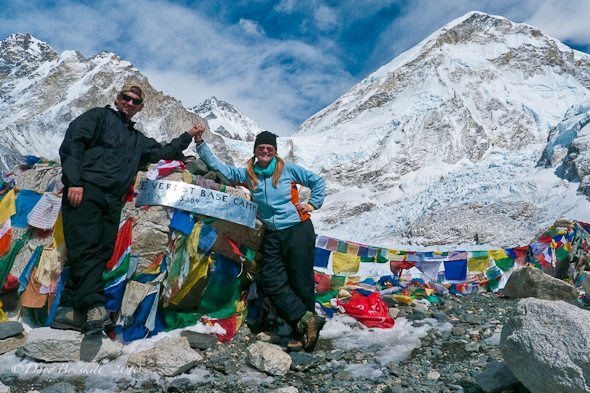

- 1 wind/rain proof overlayer– jacket and pants
- 1 down jacket – didn’t really need this, layers would have been fine, but it does get quite cold in March. We are fans of the Canada goose Hybridge down jacks. Plus, a down jacket was great to sleep in.
- 1 down vest – I bought this in Kathmandu and loved having it to lounge around the tea houses. Down is very lightweight, so it doesn’t take up a lot of space.
- 1 Warm winter hat – We bought sherpa hats in Namche Bazaar and they worked like a charm.
- 1 lightweight thermal layer hat – Weather varies on the mountain. I liked having a hat to keep my ears warm, but a light one was sufficient at lower altitudes.
- 1 peak hat – The sun is strong above the clouds, a peak hat is a must.
- 1 headband/buff – I love hiking in a buff. I put it around my neck when I’m cold and put it on my head to keep sweat out from running in my face when its hot.
- 1 pair gloves – It is cold (especially in March) above 4000 meters. Your fingers will thank you.
- 1 Pair trekking/hiking boots – Be sure to have used your boots beofre your trek. Don’t buy brand new boots. They should be worked in and well worn. That way you won’t get surprise blisters. We are fans of Merrell Hiking boots.
- 1 Pair crocks or Birkenstocks – I recommend sandals that you can wear with socks instead of flipflops. I
- 1 pair down booties – We bought these at Namche Bazar and they saved our feet.) Great for keeping feet warm in the room (as teahouse rooms are not heated) and while sleeping and for in the lodge.
Trekking Gear for Everest Base Camp
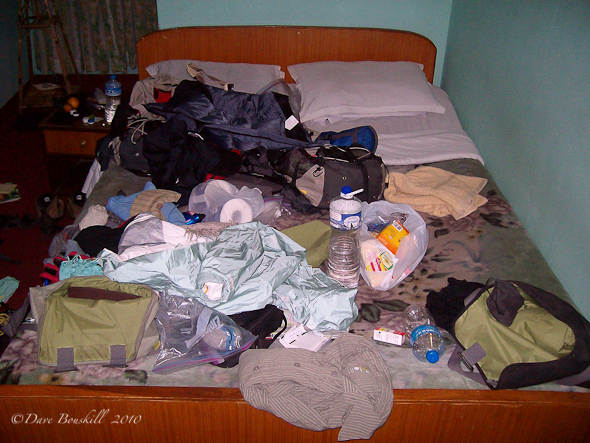

Since you are staying in Tea houses when climbing to Everest Base Camp, you don’t need a lot of extra travel gear. If you find you need more, you can pick up what you forgot at Namche Bazaar.
- 1 headlamp – Teahouses don’t have electricity in halls and rooms, a handsfree headlamp is a good option over a phone light.
- 1 sleeping bag heavy – (could have gone more lightweight as tea houses supply blankets as well. )
- 1 watch with alarm – Your cell phone will get cold at night, a good old fashioned digital watch is great for early morning wake up.
- 2 Pairs of sunglasses (in case one breaks) – Believe me, I had a pair of sunglasses break while climbing Mount Kilimanjaro and I regret not having extra sunglasses. Pack two because you don’t want to injure your eyes.
Gear for Everest Base Camp
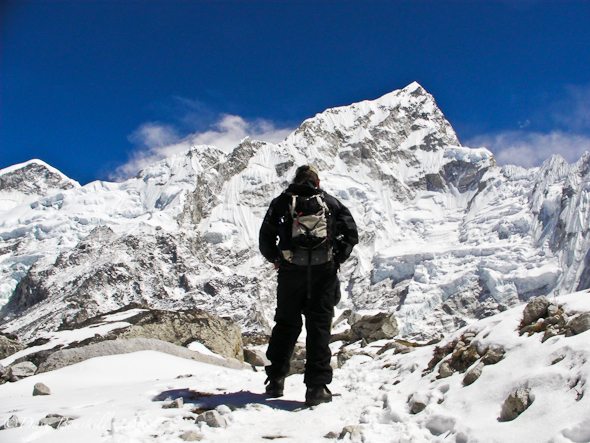

You don’t want to go overboard on carrying electronics when climbing to base camp. Every extra piece of gear will feel extremely heavy.
On the other hand, it’s a once in a lifetime chance and you will want to capture as many photos as possible.
- To see our full camera gear list, see the Complete Photography Gear Guide
- 1 DSLR camera with 3 extra batteries (charging is expensive on the mountain, but you can charge your batteries if they go dead for a fee). You also want 3 batteries because they go dead faster in the cold.
- 1 Point and shoot camera or cell phone camera – Yes, you’ll want to use your professional camera for those amazing views, but you’ll also want to be able to grab quick snaps.
- GoPro – We never travel without our GoPro, especially on adventures.
- 1 solar charger (charging is expensive if you can charge yourself will save money)
- 2-3 portable power banks – Power banks are perfect for charging your electronics. If you pack these, you won’t have to worry about paying for charging.
- Belkin mini surge protector and adapter – If you do need to charge from an outlet, this will protect your electronics from a power surge. And you can plug a lot of items into it so you won’t have to flight for an outlet with other trekkers.
- extra batteries for headlamps
Hot Tip: Keep batteries close to your body, that will make them last longer.
Teahouse Clothing


We found that we didn’t change too much from our trekking gear in the tea houses. But there were a couple of extra items we packed. You don’t need to dress up in the teahouses. It is a rugged trek after all, so you can relax and dress casual.
- I liked wearing my base layer with a merino wool skirt overtop. Dave changed into light trekking pants.
- We both wore short sleeved shirts under zipped fleece sweaters so we could peel layers off as the woodstove burned.
- Crocks with thick wool socks did the trick for us. We could slip them on and off and our feet got a break from our boots.
- When you get to higher elevations, it is colder walking from your room to the main restaurant. So, you may want to wear your base layer with trekking pants overhead.
- I don’t think I ever took my hat off on this trek.
- we don’t recommend jeans at anytime as they are heavier in weight (so why put your porter through more weight) and they aren’t quick dry. Stick with lightweight breathable materials.
Snacks and Extras


- Tang – or any other powdered juice. We bought this in Kathmandu and it helped us stay hydrated. I felt naseous sometimes due to altitude and the flavoured water made the fluid go down better. Plus it helped to replenish our electrolytes.
- Tea – you can boil water in teahouses for free.
- dairy milk bars – chocolate is a must. It is expensive on the trek, so stock up in Kathmandu.
- trail mix and peanuts – I found that I couldn’t stomach a lot of food on certain days, and trail mix and peanuts gave me the salt I needed.
- Journal – Everest is a good time to go inward and reflect. Keeping a journal will create amazing memories.
- paperback book – Skip electronics, use paper so you don’t have to worry about batteries. Check out our list 24 Best Travel Books to Inspire the Wanderer in You
First Aid for Trekking EBC


- Diamox – for altitude
- Ibuprofen (Tylenol) – for headaches
- Naproxen (Aleve) – for aches and pains
- Vicks vapor rub – I was quite congested on the mountain and slathered myself with Vicks each night.
- Sunscreen – The sun is very strong at altitude.
- Chapstick – It is very dry at altitude and your lips will most likely crack if you don’t have chapstick.
- anti nauseant – you tend to feel just a little bit nauseaus at altitude. At least I do. I find taking an anti nauseant keeps it at bay.
- Immodium – diarrhea is common at altitude especially over 5000 meters.
- blister bandaids or moleskin – Moleskin is great for blisters in boots as it doesn’t come off. Have a few bandaids on hand as well.
- eye drops – My eyes were very dry on the trek
- Advil cold and sinus or Dayquil – My sinuses became very congested and this helped me to sleep at night.
- nasal moisturizer – altitude causes nasal cavities to be very dry, nasal moisturizer was very helpful
- Q-tips
- tweezers
- tiger balm – A good rub to help with aches.
Read our complete first aid kit for travelers
Toiletries
- foot powder – great to put in boots at the end of the day.
- Toilet paper – pack your own toilet paper
- shampoo – put it in a small bottle or GoToob
- soap – For that one or two hot showers you manage to have.
- microfiber towel – for obvious reasons. A microfiber towel is lightweight
- Gold Bond – this just feels good all the time and we like this medicated bond way better than baby powder.
- nail clippers – Good to keep toenails trimmed when trekking
- The usual toiletries – toothbrush, toothpaste, different
- Hand Sanitizer –
- Baby Wipes or Wet Ones – A life Saver when you haven’t showered for days.
See what the flight from Kathmandu to Lukla was like
Documents
- Passports – You will have to show them at check points.
- TIMs Card (permit to allow you into park bought in Kathmandu)
- Plenty of Rupees – There are no ATM’s along the trail
- Map and Lonely Planet – There is a lot to read about on the trek and a lot to see. The Lonely Planet helps you know what to look for.
- Extra Passport Photos – we had to leave photos with check-in
Accessories
Ear Plugs – When staying at teahouses, there are other groups there and it can get loud.
Noise Cancelling Headphones – You may want to listen to music or watch a movie on your iPhone.
So there you have it, that’s our packing list for Everest Base Camp.
Note: We have since gone over this packing list and found that it all worked very well for Everest Base Camp Trekking.
We didn’t feel that we over packed at all and we felt that we had enough travel gear to make it through everything we needed.
Plus, we felt that we didn’t overload our porter Sher, he only had to carry one backpack between the two of us.
Going to Everest Base Camp? Read our Insider tips for trekking to EBC
See more packing and gear guides
Read More About Nepal Travel



